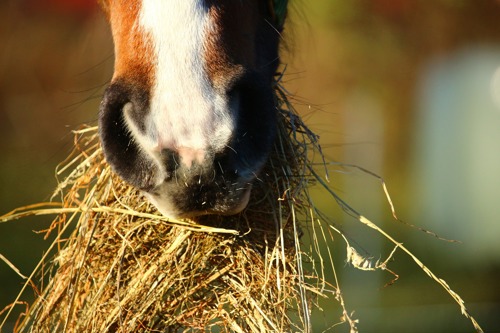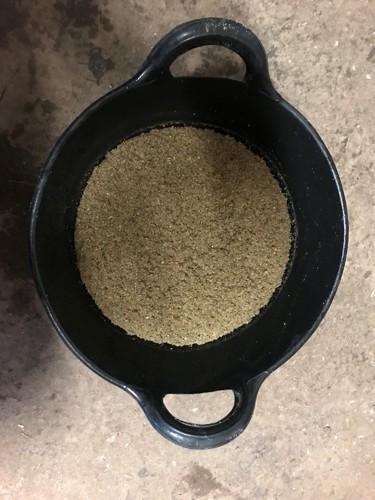From older horses or those with poor teeth, to horses who may need their forage to be enhanced, there’s certainly a place for soaked mash in some horses’ diets. The ability of the horse to chew has a direct influence on the digestion of feed. Forage is a fibrous product, and chewing prepares it for digestion. The mechanical action crushes fibre and, very importantly, promotes the creation of saliva. This mass of chewed food, when swallowed, contains components that allows the stomach to secrete acid and some enzymes which start the breakdown of feed into absorbable nutrients. This system, because of the natural trickle feeding behaviour of horses, means there is a constant flow of feed that absorbs and buffers the acid in the stomach.
There are situations, such as tooth loss and old age where a horse is not as capable of chewing fibre-rich feed as before, and this can mean we need to make gradual changes. Dental disorders become more common in older and veteran horses, but with regular dental checks (every 6-12 months) you can help to maintain your horse's dental health. If your horse isn't able to chew their food as efficiently, gradual changes to diet (over 10-14 days) may also need to be considered, as this can impact digestion and the nutrients being absorbed. Some horse owners opt for feeding chopped forage. While this does help avoid the risk of ingesting long lengths of un-chewed forage, compromised chewing may not even prepare this food properly for efficient digestion.
Another potential solution has been replacing a portion of the forage with a more easily digested energy source, such as a cereal or oil-based feed. While this can work on a nutrient basis and these feeds need less chewing, both these and short chopped forages have low acid binding capacity, which means they don’t reduce the effects of acid on the stomach lining. So, although we may be giving the right energy and nutrient profile, stomach acidity levels could be too high, and lead to a negative change in the gut’s environment. This can lead to a less than optimal digestive process and could impact on the horse’s health and overall wellbeing.
When the options above aren’t working for your horse, this is the time to consider using a mash feed.

What to look for in a mash feed
With mashes, chewing is an easier, less abrasive action resulting in greater and faster uptake compared to fresh and preserved forages. Feeding a processed fibre offsets the decreased chewing of a compromised or older horse, without disrupting the gut process that poorly chewed forage fibre would.
For many older horses, maintaining condition can be challenging even if they do not have any dental issues. Some owners are quick to assume that increasing the amount of feed will help put weight and condition on their horse, however, quality is much more effective and important, than quantity.
High fibre feeds that utilise ingredients like beet pulp, oat fibre and alfalfa are great for maintaining condition.
Beet pulp is a natural prebiotic, which means it feeds the beneficial bacteria in the gut. By including beet pulp in the diet, you can enhance fibre fermentation. It gives slow-release energy which is optimal for gut performance. The acid binding capacity of beet pulp is also high and so there’s less free stomach acid to disrupt digestion and cause further issues. The fibre digestibility is high too, compared to forage fibre, so helps support the horse’s natural decline in intake of forage that comes with age. Look for heat- and moisture-treated beet pulp as that gives the best digestibility, and in turn, soak-ability.
Alfalfa has a very high acid-binding capability which protects the stomach lining from any adverse effects.
Oat Fibre is high in beta glucans, this helps the prebiotic nature of beet pulp stick to the beneficial bacteria but also helps create an additional mucous layer in the stomach, protecting from acid splash.
One feed that includes all these ingredients is British Horse Feeds’s (BHF's) Fibre-Beet which contains Speedi-Beet, a heat- and moisture-treated beet pulp. In essence, Speedi-Beet is pre-chewed as it allows moisture and saliva through the fibrous cell walls, so doesn’t require further chewing.
Fibre-Beet combines Speedi-Beet with alfalfa which enhances the already positive benefits of feeding Speedi-Beet alone.
The combination of Speedi-Beet and alfalfa is also supplemented with biotin, sodium and calcium. Made using only the best quality British Beet Pulp, Speedi-Beet is subjected to BHF’s patented cooking process to produce a unique feed which is unlike any other horse beet. As a high fibre, beet pulp feed, Fibre-Beet is also low in sugar and starch (5% sugar, 3% starch).
If a horse requires forage supplies to be enhanced, for example if forage quality is low, then mashes such as Fibre-Beet or Speedi-Beet can also be used for this. Always consider your horses weight, body condition and workload before making any gradual changes (over 10-14 days), if necessary. If forage options are limited these high fibre feeds should be broken down into several small feeds throughout the day, to compliment the horse's natural grazing and trickle feeding behaviour.

Get in touch –we’re here to help
Opening times are 8:35 am - 5 pm from Monday – Thursday and 8:35 am - 3 pm on Friday.
*Calls may be recorded for monitoring purposes.
